CricViz: An analytical guide to the major global T20 leagues
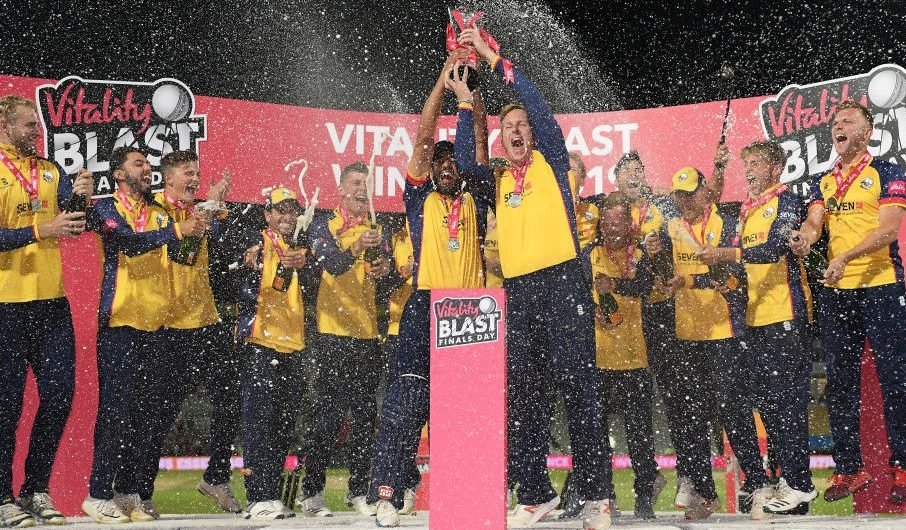
CricViz analyst Freddie Wilde tells you everything you need to know about the major global T20 leagues.
From the launching of England’s T20 Cup in 2003 up until now, the number of global T20 leagues has grown and grown. Now there are not just T20 competitions with teams from Nepal and Afghanistan attracting top international talent, but even shorter-format competitions, with T10 leagues in Dubai and the Qatar giving an even sharper thrill.
While some competitions – the likes of the Sri Lanka Premier League or the Ram Slam T20 Challenge – have come and gone, slowly a heirachy has emerged of the major global T20 leagues and the rest. But with the Champions League sadly no more, and teams from each competition therefore never meeting on the field, it can be tough to compare the relative merits of these competitions. Using analytics, we can glean as much as we can about how they compare and contrast, and look at the trends across all competitions.
Putting the vast CricViz database to good use, Freddie Wilde compiled this guide of the major global T20 leagues:
The Indian Premier League (IPL)
The big daddy of the global T20 leagues, the IPL is the world’s predominant competition on and off the pitch. No league is richer, no league pays its players more and no league produces a higher standard of cricket.
An estimated 1,000 professional cricketers in India means no league’s local talent pool is bigger and when this is combined with the largest allocation of overseas players in any league (eight per squad and four per team – all with close to full availability – spread across eight teams), a salary purse of $12 million and the world’s most well-funded and well-paid back-room staff of analysts, scouts and coaches, it is little surprise that the IPL produces the world’s best T20 cricket.
It took time for the cricket in the IPL to match the league’s economic clout but the last decade has seen a proliferation of T20 leagues in India and rapid advancement in understanding and analysis of the 20-over format in the country.
The local talent pool in India is strongest in the country’s traditional areas of dominance in longer forms of cricket: classical top-order batsmen and spin bowling. This places an emphasis on signing powerful overseas batsmen and fast bowlers at the annual auction and can make it hard for even some of the world’s leading non-Indian spin bowlers to win contracts. The last few years has seen a growth in the number of talented Indian middle-order batsmen.
Pitches in India are generally very good for batting and relatively small boundaries at most venues means the IPL is a good league for batting: since 2013 only the T20 Blast in England has returned higher run rates.
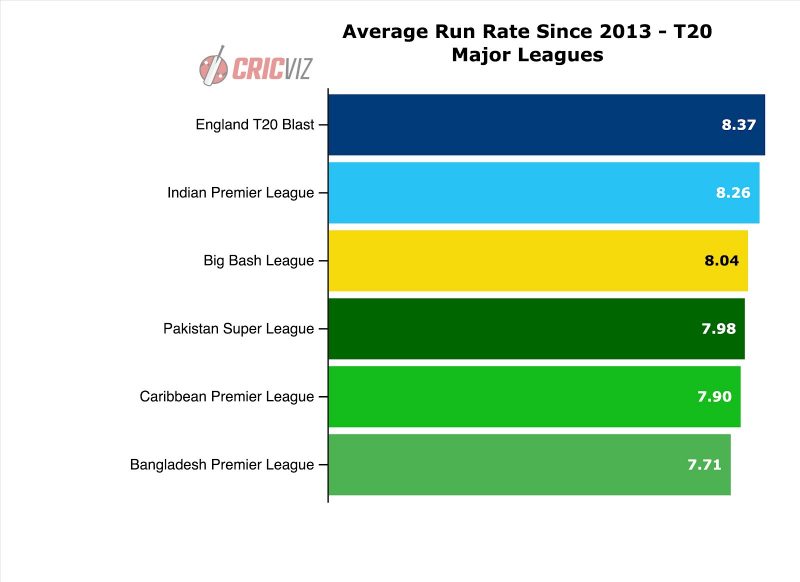
CricViz: The T20 Blast has the highest run rate of the major global T20 leagues
All but three of the IPL’s 12 editions have been won by three teams: Mumbai Indians (2013, 2015, 2017 and 2019), Chennai Super Kings (2010, 2011, 2018) and Kolkata Knight Riders (2012 and 2014). Indeed, since 2010 only one team (Sunrisers Hyderabad in 2016) have managed to break the dominance of these three teams. Three active teams: Delhi Capitals, Kings XI Punjab and Royal Challengers Bangalore have never won it.
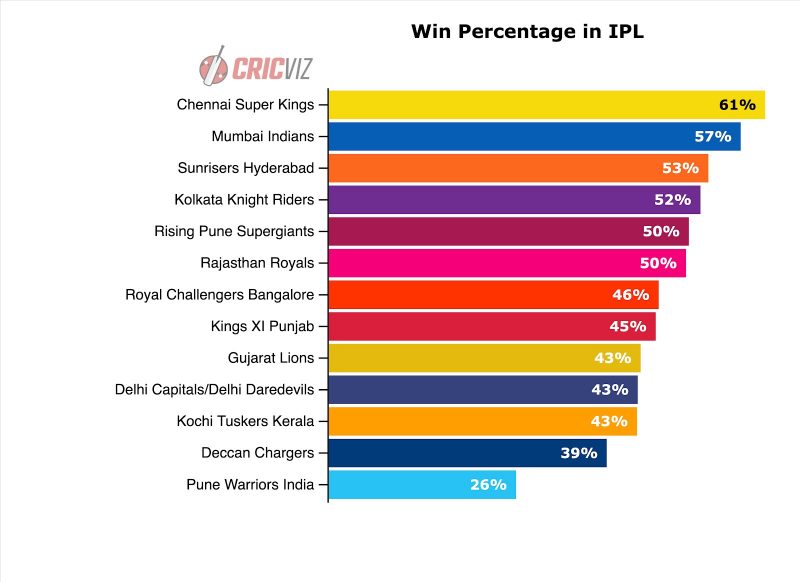
CricViz: Teams ranked by win percentage in the IPL, biggest of the major global T20 leagues
The Caribbean Premier League (CPL)
No region has produced such an array of T20 talent as the Caribbean has. Many of the CPL’s local players are among the most popular overseas players in all the other major leagues. So when this local talent pool is paired with an excellent cast of overseas players, with four permitted per team and spread across only six teams, the CPL produces a very good standard of T20 cricket.
The Caribbean has a seemingly endless supply of huge power-hitters and also produces a number of very good spinners. Overseas recruitment at the annual draft is generally focussed on pace bowlers and anchor batsmen.
A significant improvement in the quality of pitches in the Caribbean in the last few seasons has seen the average run rate in the league rise significantly across the last four, and particularly the last two, seasons.
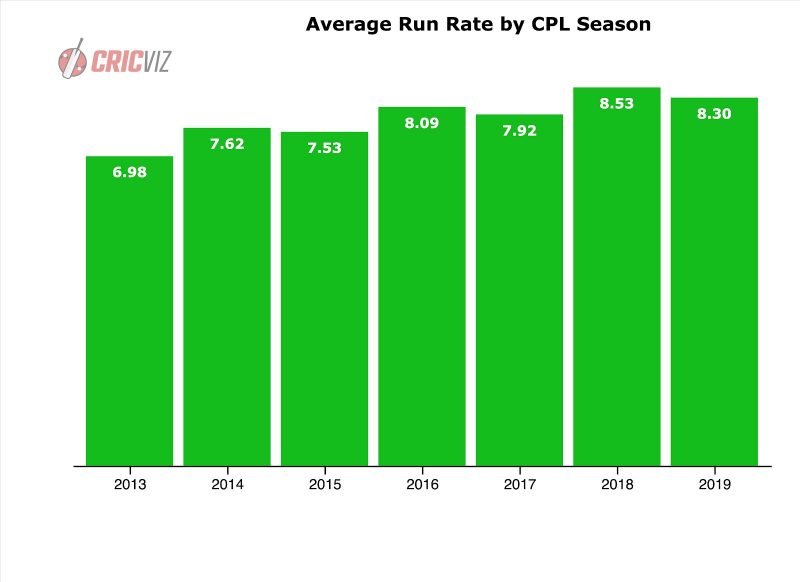
CricViz: The average run rate in the CPL has increased over the years
In the last decade the West Indies T20I team have built a dynasty on the basis of their six-hitting capabilities. It is therefore wholly appropriate that the CPL is way out in front among the major leagues for balls per six.
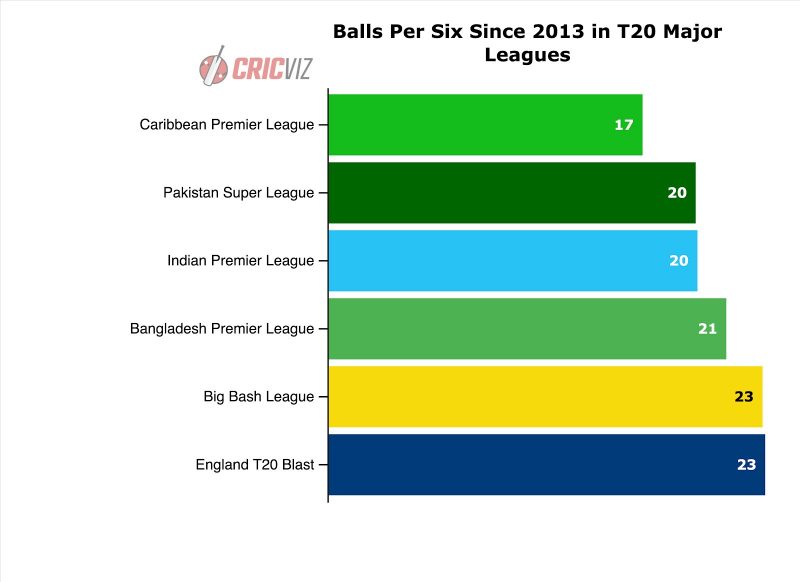
CricViz: The CPL has the fewest balls per six of any of the major global T20 leagues
To an even greater extent than the IPL the CPL has been dominated by three teams, who between them have won all seven editions of the league: Trinbago Knight Riders (2015, 2017 and 2018), Barbados Tridents (2014 and 2019) and Jamaica Tallawahs (2013 and 2016). However, the Guyana Amazon Warriors have also been a major team in the league – three times reaching the final, including last season after a streak of 12 consecutive wins.
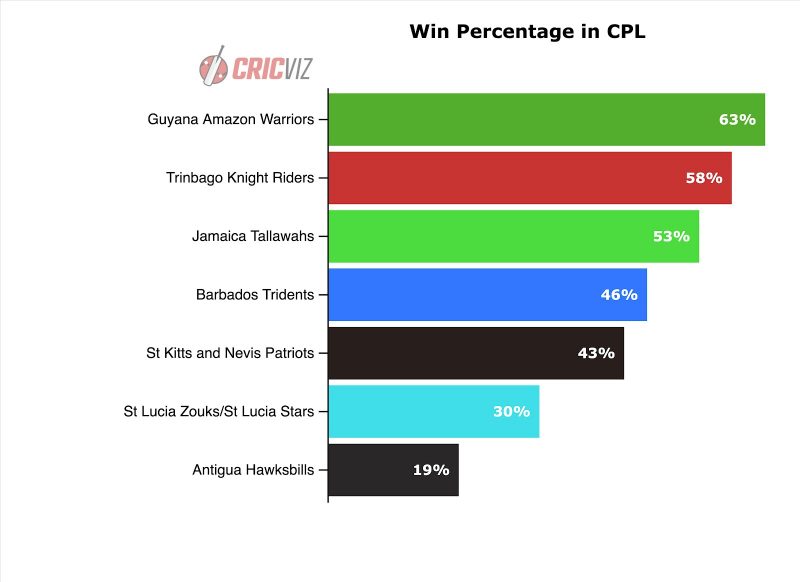
CricViz: The Guyana Amazon Warriors have never won a CPL title, despite maintaining the highest win percentage in the competition
The Pakistan Super League (PSL)
The PSL benefits from the same advantages of the CPL: high-quality local players who are always available, decent overseas players and only six teams to spread the talent between. Overall the PSL is a very similar standard to the CPL.
While the CPL is boosted by a fantastic supply of local power-hitters and spin bowlers the PSL’s local strength lies almost entirely in pace bowling. Pakistan has a superb pace bowling lineage and it is clearly apparent in every PSL season with each of the six teams typically very well stocked with superb pace bowlers capable of swinging the ball at high pace and nailing yorkers at the death. The strong supply of local quicks and relative scarcity of powerful domestic batsmen means the annual draft is marked by teams stocking up on overseas batters.
Security issues in Pakistan meant the first two editions of the PSL were played entirely in the UAE with only the latter stages of the third and fourth editions played in Pakistan. The most recent season was the first to be played entirely in front of home crowds.
The shift from the UAE to Pakistan brought a notable change in the nature of conditions: where previously matches were played on slow, low wickets in Dubai and Sharjah the pitches in Pakistan were significantly better for batting and the boundaries notably shorter.
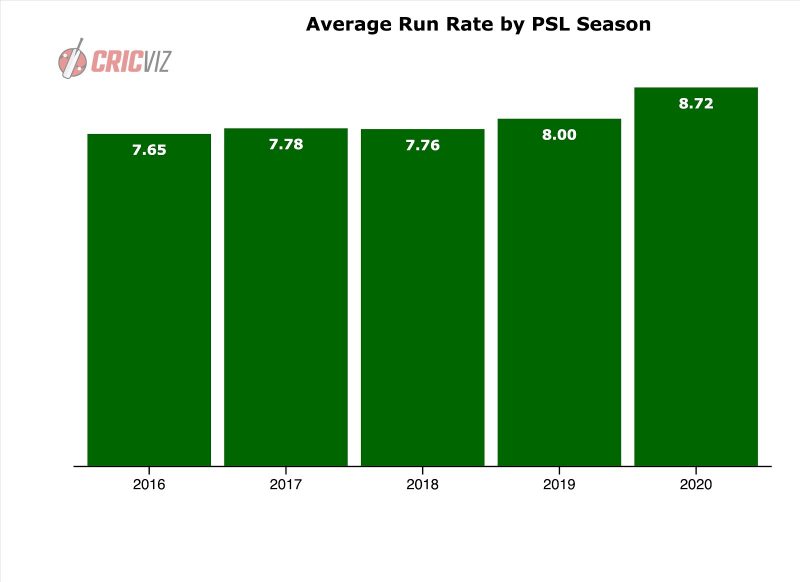
CricViz: The average run rate in the PSL has increased with the tournament’s return to Pakistan
The change in conditions saw a sharp rise in run rates and gave the league’s established hierarchy a good shake: before this year Islamabad United (champions in 2016 and 2018), Peshawar Zalmi (winners in 2017) and Quetta Gladiators (winners in 2019) were the three most successful teams with Karachi Kings also featuring regularly in the play-offs. Meanwhile Lahore Qalandars and Multan Sultans (inducted in 2018) had never reached the play-offs. However, this season Lahore qualified and Multan finished top before the Covid-19 outbreak cut the league short.
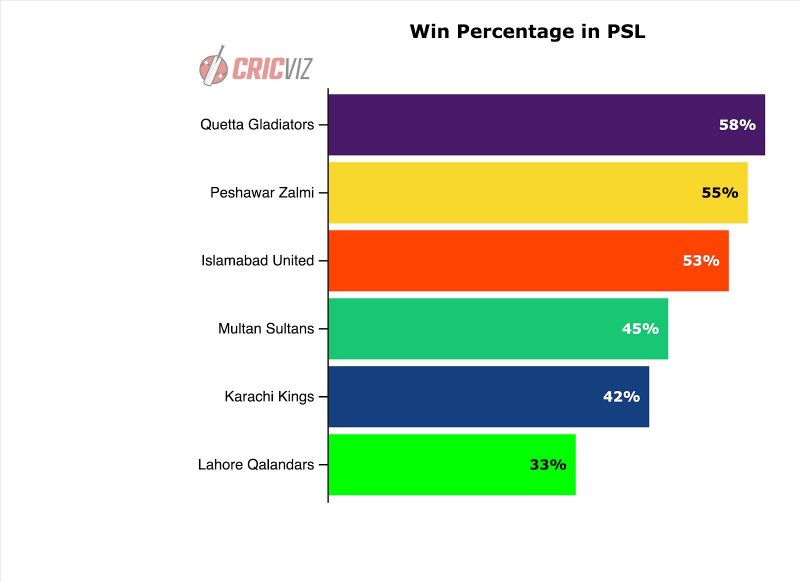
CricViz: There has been a clear split between the top three PSL teams and the rest in terms of win percentage
In recent years there has been a strong preference to chase in T20 leagues around the world but nowhere has that been more apparent than the PSL where a huge 85 per cent of toss winners have chosen to field first.
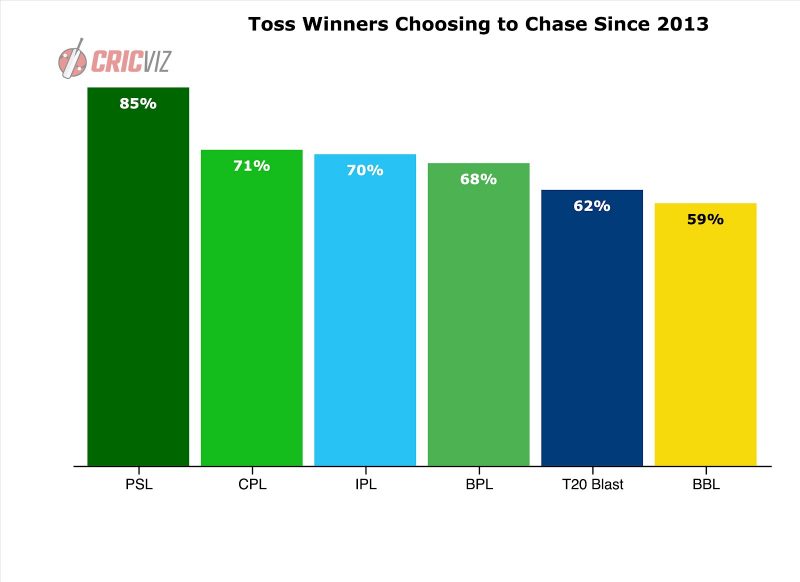
CricViz: In no other of the major global T20s have captains at the toss acted as uniformly as in the PSL
The Big Bash League (BBL)
In the early- to mid-2010s the BBL shot to prominence due to enormous crowds, huge television ratings and excellent presentation. Cricket Australia rightly received great acclaim for launching a hugely successful and popular T20 league without the injection of private investment.
However, in the last two or three years the combination of an arguably premature expansion to a full home and away season and the rise of the Bangladesh Premier League – which clashes with the BBL – has caused the league some trouble.
The BBL is one of only two major leagues – the T20 Blast is the other – which does not have a window to allow its international players to appear in the league while it is going on. David Warner, Australia’s best T20 player, has not played a BBL match since 2013.
As a result the standard of the BBL suffers significantly and is heavily dependent on overseas players for star quality. Since the 2018/19 season the BBL has clashed with the BPL which – funded by private investment – has been able to pay players significantly more money. In the 2018/19 season the BBL lost out to the BPL in signing AB de Villiers. The following season he did play in the BBL but only for a short period after Christmas.
High-quality spin bowlers are in short supply in Australia and the last few years of the BBL has been marked by a clear trend in favour of signing mystery spinners with Afghans Rashid Khan, Mujeeb Ur Rahman, Qais Ahmed and Zahir Khan all winning contracts, as well as compatriot all-rounder Mohammad Nabi.
Generally the pitches in Australia are pretty good but large boundaries mean run rates are rarely astronomically high. The move to a full home and away season caused a big drop in run rates as the pitches quickly became tired. A move to play more matches at out-grounds in 2019/20 and a concerted focus on pitch preparation saw run rates rise again.
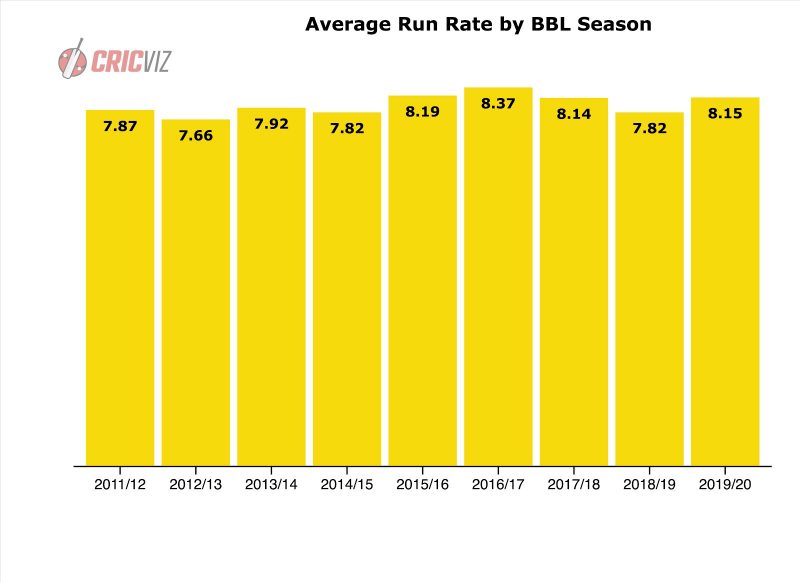
CricViz: Big boundaries have helped keep BBL run rates below 8.50 per over in all nine of its seasons
The league is largely dominated by pace bowling but the proportion of spin overs is on the rise.
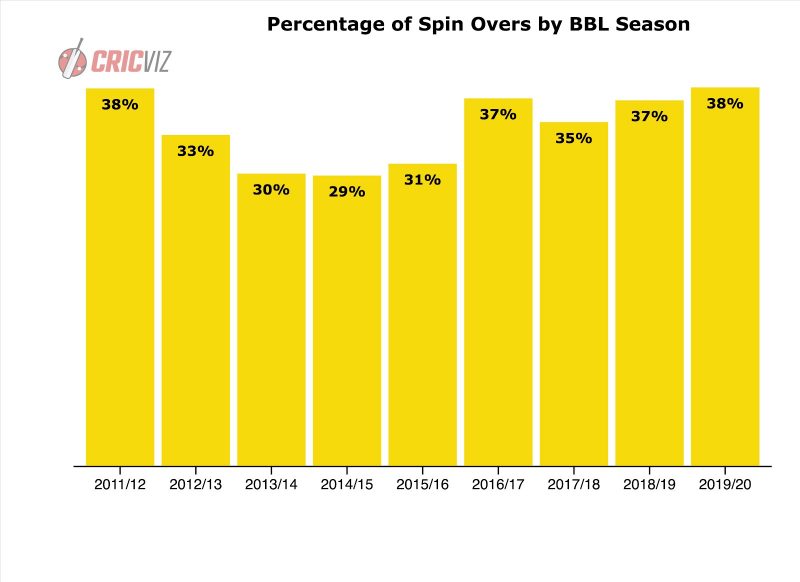
CricViz: More pace is bowled than spin in the BBL
The first six editions of the BBL were dominated by the Perth Scorchers who won three titles and reached the play-offs every season. Since then the league has been more volatile with each season producing different winners. The Melbourne Stars, like the Guyana Amazon Warriors, have been a strong team without returning a title.
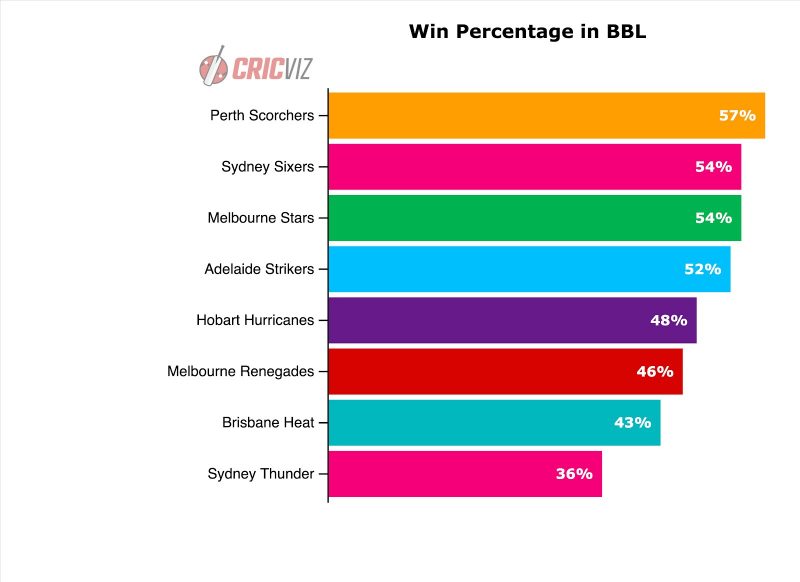
CricViz: Perth Scorchers have been the BBL’s dominant team, both by titles and win percentage
T20 Blast
England’s T20 Blast is the original T20 competition and – involving 18 teams and more than 100 matches – comfortably the largest of the major leagues in terms of size and scope.
The fact that the tournament is competed for by 18 teams who compete in all three formats and operate year-round with academies and infrastructures means they are, in many respects, more professionally run than many franchise teams around the world.
However, the fact that there are more than double the number of teams in the Blast than in any other major league means the talent is far, far more thinly spread which drastically reduces the standard of cricket as a result.
Teams in the T20 Blast are permitted two overseas players in their team and generally the competition is able to attract a fairly good calibre of overseas player but that only goes some way to making up for the drop in standard produced by having so many teams.
After years of transience and change to the structure of the competition the league has begun to adopt a more regular system in the last few years with a north group and a south group progressing to quarter finals and then the customary Finals Day. In this period the league has begun to establish an identity of very high scoring matches thanks largely to a clear shift in England to produce flatter pitches and play with smaller boundaries.
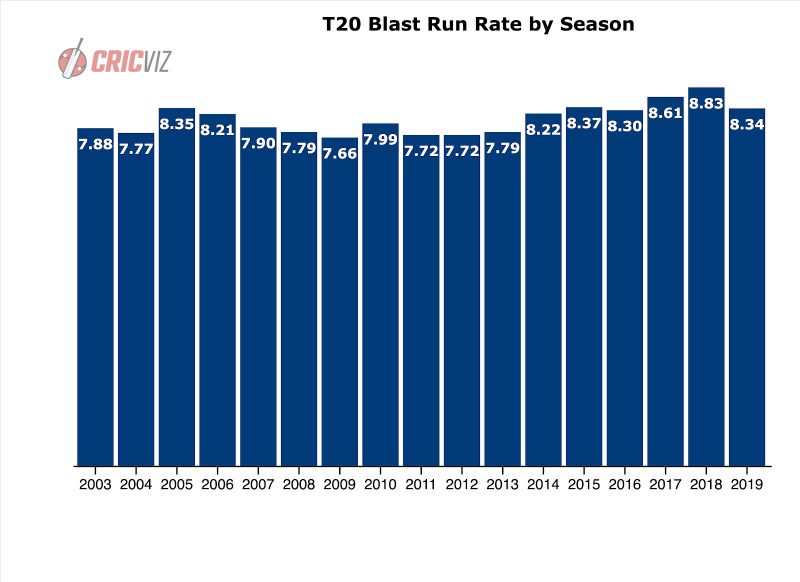
CricViz: The T20 Blast has consistently had the highest run rates of the major global T20 leagues
Unlike most T20 leagues there has been no clear overseas role preference in the Blast with the talent so thinly spread that all 18 teams are often looking to plug different gaps.
Historically pace bowling has dominated cricket in England and that has endured in T20: none of the major leagues have had a lower proportion of spin overs since 2013 than the Blast.
There have now been sixteen seasons of the T20 Blast and across that period there have been a number of successful teams: Leicestershire (champions in 2004, 2006 and 2011), then came Hampshire (2010 and 2012) and more recently Northamptonshire (2013 and 2016). The nature of the league – with three straight knock out matches – means the best team rarely lifts the trophy.
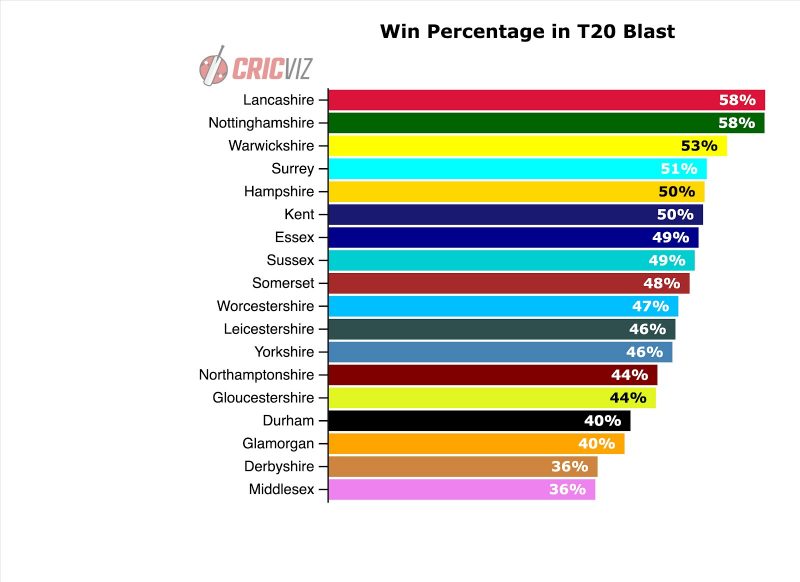
CricViz: Twelve of the 18 counties have a Blast win percentage of less than 50 per cent
Bangladesh Premier League (BPL)
The BPL is a curious league. In its early iterations it was riddled by financial problems and match fixing. However, after a two-year hiatus between 2013 and 2015 the BPL returned and on better pitches and with a far more impressive cast of overseas players it established itself as one of the world’s major leagues.
Since 2017/18 the BPL has shifted slightly later in the calendar and now clashes directly with the BBL but the private ownership model in the BPL allows it to compete and often beat the BBL to the signatures of the world’s best players. Indeed, the quality of the BPL’s overseas players is arguably second only to the IPL’s in recent times.
However, unlike the IPL – and indeed compared to all the other major leagues – the BPL’s supply of local players is poor. This brings the overall quality down considerably with only four overseas players permitted per XI.
The one area that the local talent supply is fairly well stocked in is spin bowlers. However, it is indicative of the relatively shallow domestic talent pool – but also the quality of the overseas talent pool – that overseas players of all roles are targeted by teams. Prevailing conditions and a good supply of local spinners mean the proportion of overs bowled by spin in the BPL is higher than in any other major league.
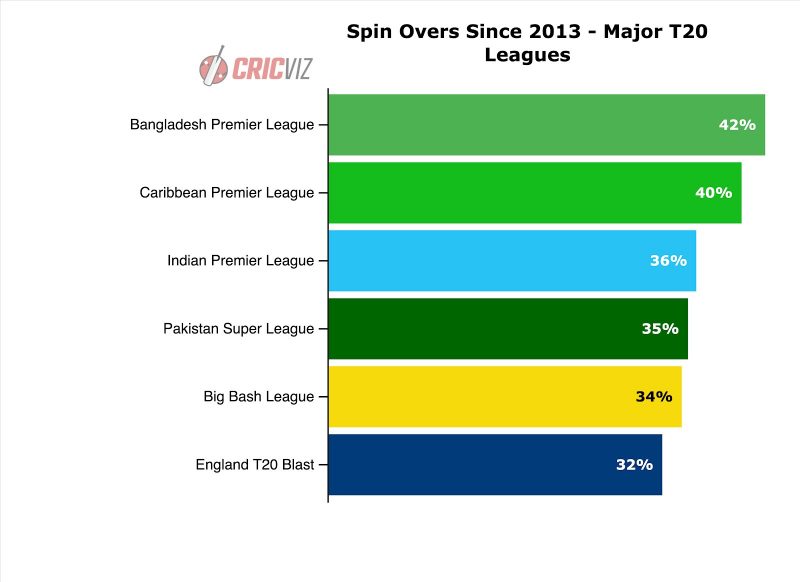
CricViz: More spin is bowled in the BPL than in any of the other major global T20 leagues
The scarcity of high-quality stadiums in Bangladesh is a problem for the BPL. In the 2015 season only two venues hosted matches: Dhaka and Chittagong. In 2016 that was increased to three with Sylhet hosting matches for the first time but the high volume of matches at such a small number of venues often causes issues with wearing pitches. However, the move to three venues has helped this issue slightly and run rates in recent years have risen slightly.
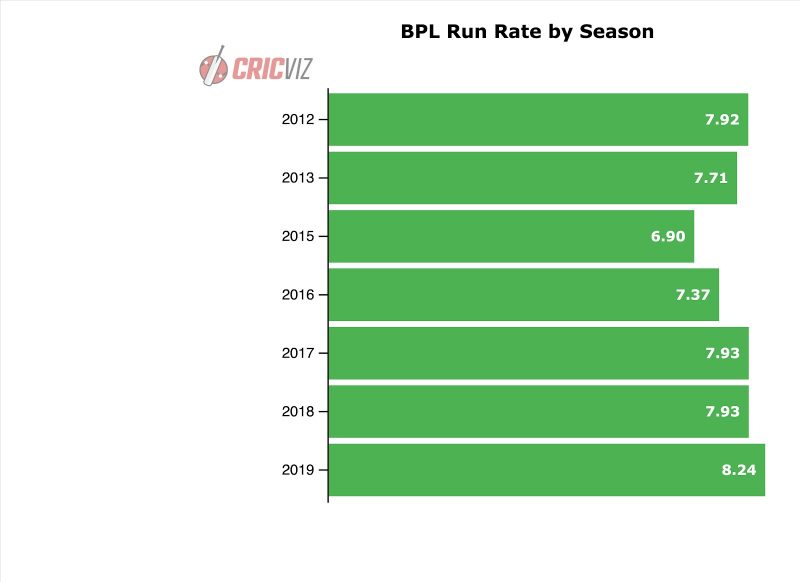
CricViz: The BPL run rates have increased since a shift to three venues
The supply of domestic batsmen – particularly powerful batsmen – is poor, which has also influenced the low run rates seen in the league.
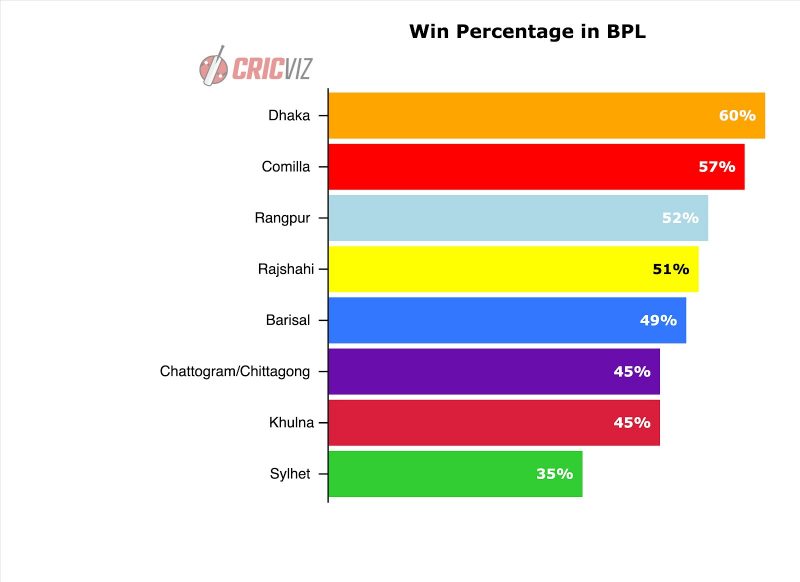
CricViz: Dhaka have been the BPL’s dominant team
The BPL has been dominated by the Dhaka-based team: first called Gladiators and then Dynamites. They won three of the first four seasons and have since twice been runners-up. Comilla have also been a force, winning two titles and reaching the play-offs once in their five seasons so far.
Freddie Wilde is an analyst at CricViz and co-author of Cricket 2.0: Inside The T20 Revolution, the Wisden Book of the Year for 2020

